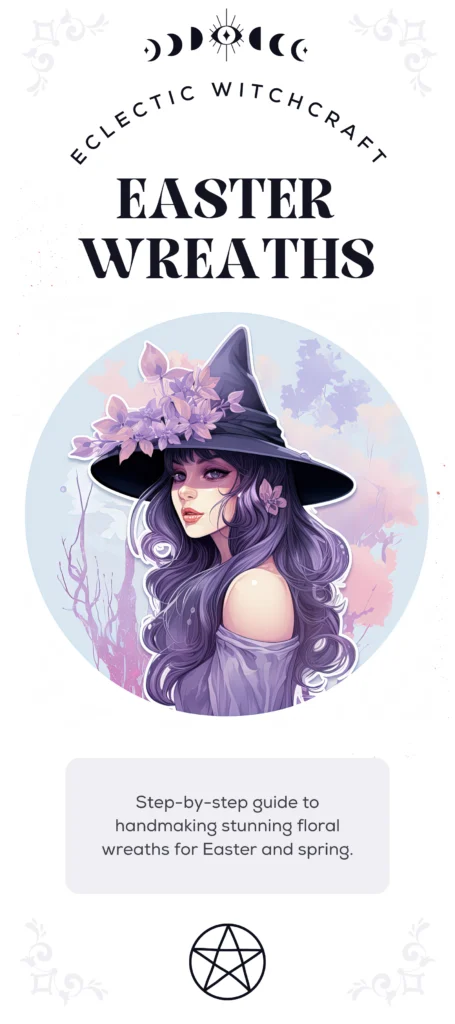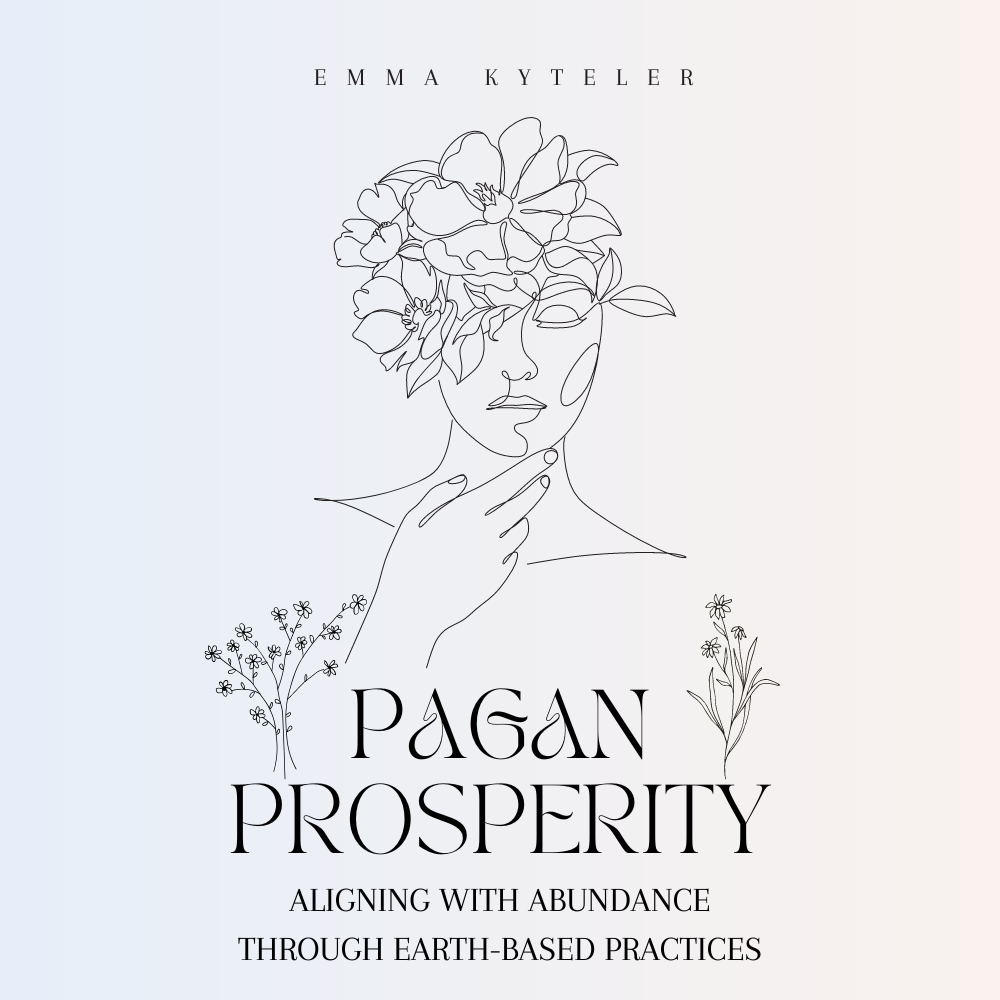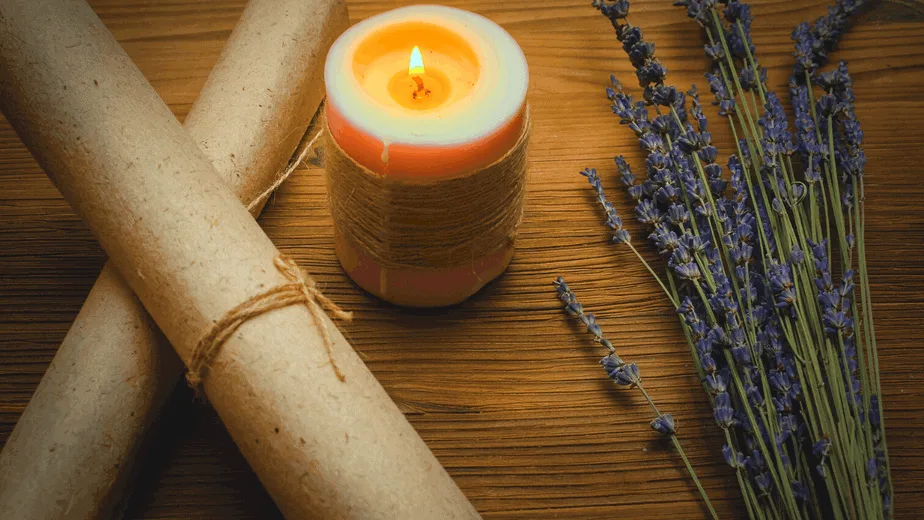Please note that posts on this site may contain affiliate links
There are few pleasures as simple and wholesome as making floral wreaths and garlands for Ostara or Easter celebrations. Decorating homes and gathering places with the first blossoms and greens of spring brings joy, hope and the spirit of renewal.
Handcrafting wreaths and garlands is also a wonderful way to express our creativity and connect with nature’s reawakening. In this comprehensive guide, we’ll explore the significance, materials, techniques and design ideas for crafting beautiful floral decorations to adorn any Ostara or Easter festivity.
The tradition of making wreaths, garlands and other arrangements of fresh flowers and foliage during springtime has endured for centuries across many cultures. Historically, these decorations held symbolic meaning and were used ritually. The circular shape of a wreath represents eternity, unity and the recurring cycles of nature. Garlands represent love, celebration and blessings for the future.
In contemporary Pagan celebrations like Ostara, floral decorations retain their magical symbolism. They also bring natural beauty and fragrance to rituals, allowing participants to more fully engage their senses. For Easter, spring wreaths and garlands signify renewal, hope and Christ’s resurrection. These decorations adorn gathering places, holidays tables and entrances to the home.
To craft fresh floral decorations, you’ll need flowers, greenery, a wreath form or garland base, floral wire and wire cutters. Dried flowers, ribbons, decorative charms and other embellishments are nice additions too. Basic materials can often be foraged from the garden. For more variety, florists, craft stores and supermarkets sell flowers and supplies.
With a little creativity and practice, anyone can develop their floral design skills. The following sections offer guidance on materials to use, design techniques, and ways to craft beautiful wreaths and garlands that will elevate any Ostara or Easter celebration.
Choosing the Right Flowers and Foliage
Selecting appropriate flowers and foliage is key for creating wreaths and garlands that look good and endure. Certain natural materials hold symbolic meaning or seasonal relevance. Following flower care and handling tips will yield the best results.
Understanding the Symbolism of Different Flowers and Foliage
Some of the flowers and greens used in Ostara or Easter decorations carry traditional symbolic associations. Here are a few to look for:
- Daffodils – Rebirth, new beginnings, happiness
- Tulips – Renewal, rebirth, divine love
- Hyacinths – Constancy, peace of mind, prosperity
- Iris – Faith, hope, cherished friendship
- Ferns – Magic, fascination, confidence
- Ivy – Endurance, faithfulness, eternal life
Keep symbolism in mind as you select materials for wreaths and garlands with spiritual or ritual significance. Alternatively, simply create arrangements according to what looks and feels festive for spring.
Tips for Selecting Fresh and Long-Lasting Flowers and Foliage
Choose flowers and greens at their peak freshness for maximum longevity. Here are some tips:
- Select flowers that are newly opened or about to open, avoiding wilted blooms.
- Look for bright green stems and foliage without brown spots.
- Opt for waxy-petaled flowers like tulips that retain moisture well.
- Pick flexible branches and stems for easiest garland shaping.
- Get large flower heads like peonies to minimize wilting.
Make clean cuts and strip excess foliage from stems. Keep materials hydrated in water until use. These measures will help ensure your wreaths and garlands look fresher longer.

Exploring Various Color Combinations and Themes
Floral decorations POP with a cohesive color story. Contrasting hues layered artfully together also create interest. Some color palette ideas include:
- Pastels – Soft pink, lavender, cream, pale yellow, mint green
- Bright Spring – Fuchsia, lime green, teal blue, lemon yellow
- Sunset – Orange, fuchsia, red, yellow, purple
- Cool Hues – Blue, green, white, silver
- Warm Hues – Red, yellow, orange, pink
Alternatively, create thematic arrangements revolving around eggs, bunnies, butterflies or symbols of renewal. Establish a color scheme and material list to match your theme. Get creative combining real blooms with faux flowers, decorative embellishments and foraged items from nature.
Basic Techniques for Wreath Making
While wreath frames provide the structure, lush florals give wreaths their beauty and fullness. Follow these basic steps for attaching flowers and creating gorgeous wreaths that make a statement.
Creating a Sturdy Base for Your Wreath
You can purchase plain wreath forms made of grapevine, straw or styrofoam. For a unique touch, create your own rang using pliable branches like willow or tree shoots. Simply bend branches into a ring shape and secure ends together with floral wire.
Other wreath base options include wire coathangers bent into rings or rings of linked pinecones. Adorn the base further by wrapping with wide ribbon. This covers the mechanics while lending color.
Step-by-Step Guide to Wiring Flowers and Foliage onto the Wreath
Cut flower and foliage stems to 4-6 inches long. Remove excess leaves so just the blooms protrude. Wrap stems with floral wire using the following technique:
- Place a stem diagonally across the base wreath ring and hold in place.
- Start about 2 inches below the flower head and tightly wrap wire around the base wreath and stem together.
- Wrap down the stem 2 more inches, securing it firmly to the wreath.
- Bend or cut off any excess stem length.
- Repeat process, spacing wired stems 2-3 inches apart around wreath until it’s covered. Try mixing up directions and elevations of stems for fullness.
- To fill gaps, add small filler flowers and greens by wiring or tucking stems into place between larger blooms.
Adding Decorative Elements and Finishing Touches
Embellish your wreath to complement the flowers and foliage. Try adding:
- Ribbons, bows, beads, bells or other accessories
- Eggs, nests, butterflies or other symbolic charms
- Foraged finds like feathers, moss, acorns, dried pods
- Intersperse faux flowers for pops of color
For longevity, lightly spritz wreath with floral preservative solution. Finish by hanging on the wall, door or other display location. Enjoy the beauty of your floral handiwork!

Basic Techniques for Garland Making
Garlands offer flexibility to drape over mantles, railings, arches or down table centers. Follow these guidelines for crafting stunning floral garlands by hand.
Selecting the Right Base for Your Garland
Rope, twisted jute or a linked chain of greens make ideal garland bases. Willow branches linked end-to-end with wire also work well. Choose a flexible base that can be shaped as desired.
For very long garlands, construct a sturdy linked base by wiring together 3-4 feet lengths of greenery or branches. Joining multiple prepared sections is easier to handle than making one overly long garland.
Attaching Flowers and Foliage to the Garland Base
Cut stems to various lengths up to 8 inches. Place stems along the garland base at pleasing intervals and angles. Wrap stems to base with floral wire using the same technique as wreath-making:
- Cross stem over base and hold in place.
- Wrap wire firmly around stem and base 2-3 inches.
- Add next stem and repeat. Position pieces low and high for fullness and dimension.
- Trim any excess stem length.
Enhancing the Garland with Ribbons, Bows, or Other Adornments
Consider supplementing flowers with:
- Wide ribbons woven along the garland length
- Bows, beads, bells or charms wired to drape points
- Feathers, vines, moss or foraged elements
- Battery-operated string lights for magical ambiance
Lightly spritz finished garland with floral preservative before displaying for optimal longevity. Shape and drape your garland as desired to show off its handcrafted glory!
Designing and Styling Wreaths and Garlands
Take your wreaths and garlands to the next level with inventive shapes, layered textures and foraged embellishments. Here are some ideas for visually striking floral designs that suit Ostara’s spirit.
Exploring Different Styles and Designs for Wreaths and Garlands
Move beyond round, uniform wreaths and straight garland strands. Try weaving materials into freeform organic shapes. Or incorporate unexpected materials like branches or food. Some options include:
- Hoop wreath on a square metal ring or hula hoop base
- Teardrop or crescent shaped wrist corsage
- Garland inside a wire tomato cage silhouette
- Wreath in the shape of a heart, butterfly or initial
Tips for Creating Balanced and Visually Appealing Arrangements
- Vary flower sizes, shapes and colors for balanced interest
- Mix overly full areas with negative space
- Repeat motifs like groups of 3 eggs through the design
- Layer materials so all are visible from front view
- Angle stems in different directions
Incorporating Additional Elements like Feathers, Eggs, or Symbolic Charms
Look to nature and seasonal symbols to embellish wreaths and garlands meaningfully.
- Wire in feathers found on walks for an ethereal effect
- Affix decorative eggs using hot glue gun or ornament hooks
- Incorporate laser cut botanical shapes or animal charms
- Suspend bells, crystals or goddess charms with ribbons
- Display wreaths on colorful platters or stands as a base
Foraged elements lend a wild, organic feel. Unique accents personalize decorations to suit the character of your celebration.
Advanced Techniques and Special Effects
Once comfortable with the basics, try your hand at intriguing advanced wreath and garland designs. These methods add artful impact for Ostara festivities.
Creating Asymmetrical Wreaths and Garlands
Symmetrical wreaths and garlands exude a formal, orderly aesthetic. For a more organic look, use asymmetrical design concepts:
- Vary left/right density and dimensions
- Cluster materials in triangular or diagonal shapes
- Incorporate trailing vines or branches
- Mix high and low elevation freely
- Allow some ends to remain loose and untrimmed
Adding Dimension with Layering and Cascading Techniques
Build depth by layering materials:
- Place wreath layers inside one another, reducing sizes incrementally
- Begin garlands tight and full, transitioning to loose and trailing
- Push stems through prior foliage layers so flowers pop forward
- Let materials cascade down wreath sides or over edges for an enchanting effect
Incorporating Lighting, Glitter, or Other Special Effects
- Wrap wreaths around LED vine lights or string lights for nighttime magic
- Dust flowers with cosmetic shimmer powder or glitter spray
- Spritz glitter vine garlands with decorative iridescent mists
- Affix fiber optic flower picks that magically light up indoors
- Line interior wreath rings with cellophane for a colorful glow effect
With a little practice and imagination, you can create showstopping wreaths and garlands perfect for any Ostara or Easter celebration. Part of the pleasure is simply spending time immersed in nature’s beauty while crafting unique floral decorations.
Care and Preservation of Floral Wreaths and Garlands
Extend the lifespan of your handcrafted spring wreaths and garlands using proper care techniques. Follow these tips so your decorations look lovely for as long as possible:
- Display out of direct sun to prevent premature fading.
- Mist occasionally with floral preservative solution.
- Keep away from heat sources like fireplaces or vents.
- Store flat in a cool dark place between displays.
- Consider drying techniques to preserve arrangements.
To refresh drooping wreaths or garlands:
- Recut 2-3 inches off stems and plunge back into warm water for 1 hour.
- Replace spent blooms and foliage with fresh materials as needed.
- Lightly prune and fluff entire arrangement with fingers or a pick.
- Mist again with floral preservative before redisplaying.
With proper hydration, temperature control and handling, most fresh floral decorations can grace indoor festivities for up to 2 weeks. Craft your wreaths and garlands weeks before Ostara or Easter, then care for them to stay looking their best throughout the celebrations.
The return of life and light each spring is a magical gift to be appreciated. Commemorating Ostara and Easter with natural floral decorations allows us to fully engage with the symbolic meaning of these holidays.
Making wreaths and garlands by hand enables creative expression and a deeper connection to the seasonal beauty around us. With an array of possible materials and techniques to draw upon, the possibilities for springtime floral designs are truly endless. Crafting floral decor is also a practice in mindfulness, forcing us to slow down and be fully present.
This Ostara and Easter season, may your home and gatherings be adorned with floral finery handmade lovingly to reflect the joy, optimism and renewal that comes with welcoming spring.
Unearth Your Wealth: Harness the Power of Saturn and the Earth Element for Abundant Prosperity
Have you ever wondered if the stars and the elements could unlock your true financial potential? If you're ready to embark on a transformative journey, our book "Unearth Your Wealth: Harness the Power of Saturn and the Earth Element for Abundant Prosperity" is the mystical guide you've been waiting for!



